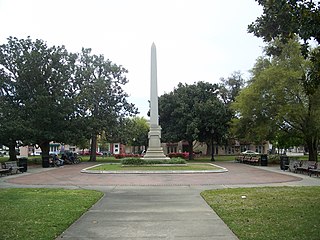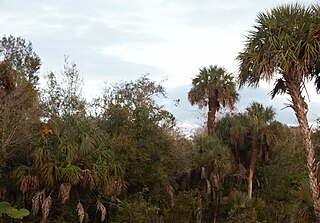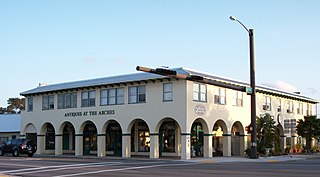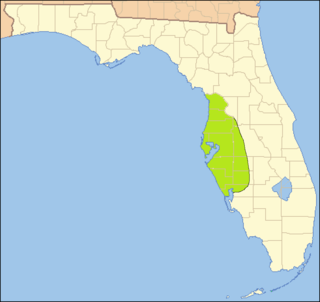
There are more than 1,800 properties and districts listed on the National Register of Historic Places in Florida. They are distributed through 66 of the state's 67 counties. Of these, 42 are National Historic Landmarks.
This National Park Service list is complete through NPS recent listings posted August 4, 2023.

The Kolomoki Mounds is one of the largest and earliest Woodland period earthwork mound complexes in the Southeastern United States and is the largest in Georgia. Constructed from 350CE to 600CE, the mound complex is located in southwest Georgia, in present-day Early County near the Chattahoochee River.

The Plaza Ferdinand VII is an outdoor garden and park in the Historic Pensacola Village area of downtown Pensacola, Florida. It is located on Palafox Street between Government and Zaragoza Streets. It was named after Ferdinand VII of Spain, the King of Spain between 1813 and 1833. A National Historic Landmark, it is the site of the formal transfer of Florida to United States jurisdiction in 1821.

The University of Florida Campus Historic District is a historic district on the campus of the University of Florida in Gainesville, Florida. The district, bounded by West University Avenue, Southwest 13th Street, Stadium Road and Gale Lemerand Drive, encompasses approximately 650 acres (2.6 km2) and contains 11 listed buildings plus contributing properties. On April 20, 1989, it was added to the National Register of Historic Places. On June 24, 2008, additional information was approved which resulted in the addition of 6 contributing properties
The Hinson Mounds (8Cr180) comprise an archeological site in Collier County, Florida near Miles City. It is located three miles northeast of Miles City. The mounds were estimated to have been used for burial from 400 - 900 AD, and they were part of the Glades culture. Excavation of the mounds, which were found on a hardwood hammock island, has produced evidence of prehistoric Native American occupation.
The Burns Lake Site is a historic site in Ochopee, Florida. It is located three miles west of Ochopee on U.S. 41. On May 27, 1986, it was added to the U.S. National Register of Historic Places.
The Halfway Creek Site is an archaeological site located near Carnestown, Florida. On August 15, 1980, it was added to the U.S. National Register of Historic Places.
The C. J. Ostl Site is an archaeological site in Ochopee, Florida. It is located off U.S. 41, near Fifty-Mile Bend. On December 15, 1978, it was added to the U.S. National Register of Historic Places.
The Sugar Pot Site is an archaeological site near Ochopee, Florida. It is located in the Big Cypress National Preserve. On December 15, 1978, it was added to the U.S. National Register of Historic Places.
The Turner River Site is an archaeological site in the Ten Thousand Islands region of Everglades National Park, in Florida. It is listed on the U.S. National Register of Historic Places.

Platt Island is an archaeological site off Florida State Road 29 in Collier County north of Miles City. It was added to the U.S. National Register of Historic Places in 1978. Ceramic fragments dated to about 2500 years old were found at the site, which is in the Big Cypress National Preserve.

The Keewaydin Club is a historic site in Naples, Florida. The Inn, which opened in 1934 and closed in 1999, is located at the north end of Keewaydin Island. On December 22, 1987, it was added to the U.S. National Register of Historic Places. The Island remained basically natural with no cars or vehicles other than a golf cart at the club on the few southern hundred yards of the 7 mile long island where the rustic but charming club and its guest cottages were located. The island guest strollers would carefully scan the tidal harvest for the daily incoming batch of sea shells, one of the best beaches in Florida for finding many unusual specimens. From mid island, beach walkers could see Marco Island in the distance, highly glitzy and very developed since the 1960s, the opposite of the old pre World War II Florida on untouched and in no way commercialized or developed Keewaydin Island.

The Everglades Laundry is a historic site at 105 West Broadway in Everglades City, Florida.

The Roberts Ranch is a historic site in Immokalee, Florida. It is located at 1215 Roberts Avenue. On October 4, 2003, it was added to the U.S. National Register of Historic Places.

The Royal Park Arcade is a historic site in Vero Beach, Florida. It is located at 1059 21st Street. On July 31, 1998, it was added to the U.S. National Register of Historic Places.

This is a list of the National Register of Historic Places listings in Collier County, Florida.

The Old Collier County Courthouse is a historic two-story concrete and stucco courthouse building located in Everglades City, Florida. Designed in the Classical Revival style, it was built in 1926 by Barron Collier, who developed Collier County and for whom the county was named. In 1962, the county seat was moved to East Naples and a new courthouse complex was built there. The building later served as the Everglades City Hall.

The Safety Harbor culture was an archaeological culture practiced by Native Americans living on the central Gulf coast of the Florida peninsula, from about 900 CE until after 1700. The Safety Harbor culture is defined by the presence of Safety Harbor ceramics in burial mounds. The culture is named after the Safety Harbor site, which is close to the center of the culture area. The Safety Harbor site is the probable location of the chief town of the Tocobaga, the best known of the groups practicing the Safety Harbor culture.
This is a list of the National Register of Historic Places listings in Everglades National Park.
This is a list of the National Register of Historic Places listings in Big Cypress National Preserve.















